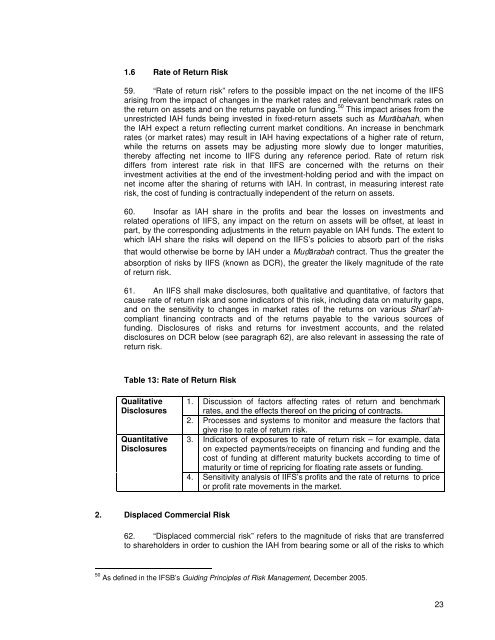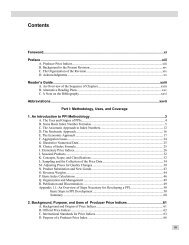Disclosures to Promote Transparency and Market - IFSB
Disclosures to Promote Transparency and Market - IFSB
Disclosures to Promote Transparency and Market - IFSB
You also want an ePaper? Increase the reach of your titles
YUMPU automatically turns print PDFs into web optimized ePapers that Google loves.
1.6 Rate of Return Risk<br />
59. “Rate of return risk” refers <strong>to</strong> the possible impact on the net income of the IIFS<br />
arising from the impact of changes in the market rates <strong>and</strong> relevant benchmark rates on<br />
the return on assets <strong>and</strong> on the returns payable on funding. 50 This impact arises from the<br />
unrestricted IAH funds being invested in fixed-return assets such as Murābahah, when<br />
the IAH expect a return reflecting current market conditions. An increase in benchmark<br />
rates (or market rates) may result in IAH having expectations of a higher rate of return,<br />
while the returns on assets may be adjusting more slowly due <strong>to</strong> longer maturities,<br />
thereby affecting net income <strong>to</strong> IIFS during any reference period. Rate of return risk<br />
differs from interest rate risk in that IIFS are concerned with the returns on their<br />
investment activities at the end of the investment-holding period <strong>and</strong> with the impact on<br />
net income after the sharing of returns with IAH. In contrast, in measuring interest rate<br />
risk, the cost of funding is contractually independent of the return on assets.<br />
60. Insofar as IAH share in the profits <strong>and</strong> bear the losses on investments <strong>and</strong><br />
related operations of IIFS, any impact on the return on assets will be offset, at least in<br />
part, by the corresponding adjustments in the return payable on IAH funds. The extent <strong>to</strong><br />
which IAH share the risks will depend on the IIFS’s policies <strong>to</strong> absorb part of the risks<br />
that would otherwise be borne by IAH under a Muḍārabah contract. Thus the greater the<br />
absorption of risks by IIFS (known as DCR), the greater the likely magnitude of the rate<br />
of return risk.<br />
61. An IIFS shall make disclosures, both qualitative <strong>and</strong> quantitative, of fac<strong>to</strong>rs that<br />
cause rate of return risk <strong>and</strong> some indica<strong>to</strong>rs of this risk, including data on maturity gaps,<br />
<strong>and</strong> on the sensitivity <strong>to</strong> changes in market rates of the returns on various Sharī`ahcompliant<br />
financing contracts <strong>and</strong> of the returns payable <strong>to</strong> the various sources of<br />
funding. <strong>Disclosures</strong> of risks <strong>and</strong> returns for investment accounts, <strong>and</strong> the related<br />
disclosures on DCR below (see paragraph 62), are also relevant in assessing the rate of<br />
return risk.<br />
Table 13: Rate of Return Risk<br />
Qualitative<br />
<strong>Disclosures</strong><br />
Quantitative<br />
<strong>Disclosures</strong><br />
1. Discussion of fac<strong>to</strong>rs affecting rates of return <strong>and</strong> benchmark<br />
rates, <strong>and</strong> the effects thereof on the pricing of contracts.<br />
2. Processes <strong>and</strong> systems <strong>to</strong> moni<strong>to</strong>r <strong>and</strong> measure the fac<strong>to</strong>rs that<br />
give rise <strong>to</strong> rate of return risk.<br />
3. Indica<strong>to</strong>rs of exposures <strong>to</strong> rate of return risk – for example, data<br />
on expected payments/receipts on financing <strong>and</strong> funding <strong>and</strong> the<br />
cost of funding at different maturity buckets according <strong>to</strong> time of<br />
maturity or time of repricing for floating rate assets or funding.<br />
4. Sensitivity analysis of IIFS’s profits <strong>and</strong> the rate of returns <strong>to</strong> price<br />
or profit rate movements in the market.<br />
2. Displaced Commercial Risk<br />
62. “Displaced commercial risk” refers <strong>to</strong> the magnitude of risks that are transferred<br />
<strong>to</strong> shareholders in order <strong>to</strong> cushion the IAH from bearing some or all of the risks <strong>to</strong> which<br />
50 As defined in the <strong>IFSB</strong>’s Guiding Principles of Risk Management, December 2005.<br />
23
















